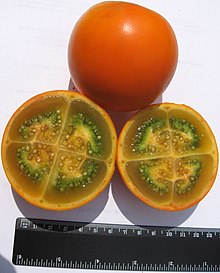| Solanum quitoense | |
|---|---|

| |
| Whole and transversely-cut fruit | |
| Scientific classification | |
| Kingdom: | Plantae |
| Clade: | Tracheophytes |
| Clade: | Angiosperms |
| Clade: | Eudicots |
| Clade: | Asterids |
| Order: | Solanales |
| Family: | Solanaceae |
| Genus: | Solanum |
| Species: | S. quitoense
|
| Binomial name | |
| Solanum quitoense | |
| Synonyms[1][2] | |
| |
Solanum quitoense, known as naranjilla[3] (Spanish pronunciation: [naɾaŋˈxiʝa], "little orange") in Ecuador, Costa Rica, and Panama and as lulo ([ˈlulo], from Quechua) in Colombia, is a tropical perennial plant from northwestern South America. The specific name for this species of nightshade means "from Quito."[4]
The lulo plant has large elongated heart- or oval-shaped leaves up to 45 cm in length. The leaves and stems of the plant are covered in short purple hairs. Naranjilla are delicate plants and must be protected from strong winds and direct sunlight. They grow best in partial shade.
The fruit has a citrus flavour, sometimes described as a combination of rhubarb and lime. The juice of the naranjilla is green and is often used as a juice or for a drink called lulada.
- ^ Cite error: The named reference
solanaceae sourcewas invoked but never defined (see the help page). - ^ Tropicos
- ^ USDA, NRCS (n.d.). "Solanum quitoense". The PLANTS Database (plants.usda.gov). Greensboro, North Carolina: National Plant Data Team. Retrieved 17 November 2015.
- ^ Lamarck, Jean Baptiste Antoine Pierre de Monnet de. Tableau Encyclopédique et Methodique ... Botanique 2: 16. 1794.